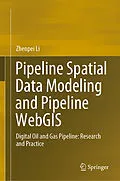This monograph, which is the first book focusing on "Digital Oil & Gas Pipeline", introduces the author's long-term research and practice on this topic. It introduces the latest research on the core technologies of the Digital Oil & Gas Pipeline, such as WebGIS, GIS Web Services, pipeline supervisory control and data acquisition (SCADA), OLE for Process Control, networked virtual reality, and Extensible 3D. The keys to the Digital Oil & Gas Pipeline, including pipeline spatial data model, pipeline WebGIS, integrity of pipeline SCADA and pipeline GIS, pipeline networked virtual reality system, are also elaborated. The knowledge and experience delivered by this monograph will provide a useful reference for readers from the industries in Oil & Gas Storage and Transportation, pipeline automation, GIS, Virtual Reality, and related fields.
Autorentext
Zhenpei Li has a master degree in Mechanical Engineering, and a Ph.D degree in Control science and Engineering, both from Northwestern Polytechnical University, Xi'an, China. He became a lecturer at the School of Civil & Architecture, Southwest Petroleum University, Chengdu, China since 2011 after getting his Ph.D degree. He is currently an Associate Professor at the School of Civil & Architecture, Southwest Petroleum University. From June 2014 to July 2016, he was a Mitacs Elevate Postdoctoral Fellow at Department of Geography, University of Western Ontario, London, Canada. He has more than ten years of experience in Oil & Gas pipeline research and application, especially in the field of pipeline data model. His research focuses on Geospatial technology and its application in Oil & Gas pipeline, Pipeline Integrity Management, pipeline spatial data modeling, pipeline leak detecting and locating, 3DGIS, WebGIS, Web3D and Networked Virtual Reality.
Inhalt
Preface
Chapter 1. Introduction
1.1 The advent of Digital Pipeline
1.2 The relation between Digital Pipeline and Digital Earth
1.2.1 Digital Earth1.2.2 The application levels of Digital Earth and Digital Pipeline
1.3 Digital Pipeline
1.3.1 The concept of Digital Pipeline
1.3.2 The role and significance of Digital Pipeline1.3.3 The key technologies of Digital Pipeline
1.3.4 The composed business systems of Digital Pipeline
1.3.5 The construction contents of Digital Pipeline
1.4 The application status of Digital Pipeline in the world1.5 The deficiencies of current Digital Pipeline construction
1.6 The main research contents of this monograph
Chapter 2. Digital Pipeline system architecture
2.1 The goal of the Digital Pipeline system
2.2 The design principle of the Digital Pipeline system
2.3 Digital Pipeline system function modules design
2.4 Digital Pipeline system network architecture design
Chapter 3. Pipeline Spatial Data Model
3.1 Overview of spatial data model
3.1.1 Spatial data
3.1.2 Spatial data model
3.1.3 The development of spatial data model3.1.4 Geodatabase data model
3.2 Linear referencing system and dynamic segment
3.2.1 Linear referencing system
3.2.2 Linear referencing system components3.2.3 Dynamic segment technology
3.2.4 Dynamic segment algorithm
3.2.5 Application examples of linear referencing system and dynamic segment
3.3 The comparison of pipeline data models3.3.1 Integrated Spatial Analysis Techniques
3.3.2 Pipeline Open Data Standard
3.3.3 ArcGIS Pipeline Data Model
3.3.4 PODS and APDM
3.4 Pipeline Spatial Data Model design and implementation
3.4.1 The design principle of PSDM
3.4.2 PSDM' linear referencing network
3.4.3 PSDM' element classification
3.4.4 PSDM' hierarchy
